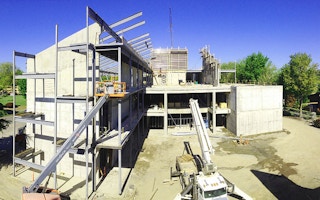“Further, faster ambition together” is the mission statement of the global leaders attending the 23rd Conference of the Parties to the UN Convention on Climate Change (COP23) in Bonn. It has been met with a mixture of scepticism and urgency, particularly after the new raised projections for this year’s global carbon emissions suggested a peak has yet to be reached.
As part of the conference, cities and regions across the world are adopting the Bonn-Fiji Commitment on climate action. It aims to remove up to 1.3 billion tons of CO₂ equivalent per year by curbing emissions at the local level. The system being put in place to deliver the commitment does appear impressive, but look more carefully and it seems to see sustainable cities in very much the same way as usual: primarily cutting emissions from heat and transport and by installing more renewable energy.
This is all essential but it misses an important part of the picture. My main area of interest is the sustainability of buildings, a key component of reducing city emissions. For years, policies and regulations have focused on reducing the energy demands of buildings while we live, shop and work in them. As a result, the potential to reduce carbon in other stages of a building’s life has remained largely untapped.
The big unsaid
What I mean here is the carbon emissions involved in making, renovating and then eventually dismantling the building. This includes everything from mining the materials for the cement to chopping down the trees for the floorboards to transporting everything to the building site to digging the foundations; and then later from knocking the building down to disposing of its constituent parts.
We sometimes refer to the emissions while a building is functioning as the operational carbon, and all the other emissions across its life cycle as the embodied carbon. Focusing on one and not the other is puzzling to say the least – we’re effectively trying to take the carbon out of our energy bills while paying no attention to the carbon in the buildings themselves.
While you can intervene along the way to improve the carbon emissions of a building’s energy use, there’s nothing you can do later about the emissions during construction. Not only that, interventions to improve a building’s energy efficiency actually make the total embodied carbon worse.
We rightly love insulation as a means of reducing a building’s heat requirement, but we install it with no regard for the carbon emissions produced in the process. And while, say, replacing fluorescent lighting with LEDs is an efficiency improvement that you can see, the carbon impact of the building will remain invisible until it has had an irreversible effect on the global environment.
“
While you can intervene along the way to improve the carbon emissions of a building’s energy use, there’s nothing you can do later about the emissions during construction.
The EU talks about Nearly Zero Energy Buildings (nZEBs) as the goal of its energy efficiency regulations. The closer it gets to this goal, the greater the share of the building’s environmental impacts when you look at carbon emissions overall. If we ever achieve nZEBs, embodied carbon will be the totality of emissions and it will be far too late to start worrying about it then. Even now, it can make up as much as 90 per cent of the whole-life emissions on some buildings, while its share is growing across the board.
What to do
So how to move forward? The most effective strategy is prevention, and a great deal can be done by designing our buildings with resource efficiency in mind. We tend to put much more materials into buildings than we need to – steel being a case in point. Buildings will still stand using much less steel, we just need to change the regulations.
There are also various other things we can do: pre-manufacturing component parts under controlled industrial conditions is an important way of saving emissions. Sourcing materials closer to home needs to be taken more seriously, as does recycling materials from old buildings and using waste to help us build. A great example is the Brighton Waste House in the south of England, which showed for instance that you can fill cavity walls with everything from old clothes to videotapes.
What this all requires is concerted and coordinated action from all the key stakeholders. Unfortunately, the COP23 Bonn-Fiji Commitment is only the latest initiative to essentially ignore this issue. Governments have broadly failed to pass regulations around embodied carbon, and the topic is often relegated to the margins or completely ignored when it comes to policymakers’ sustainability agendas. This is despite the fact that industry bodies and NGOs have actually led the way by producing a fair amount of guidance in this area.
Governments and other policy players are not even managing to agree on how to undertake a whole-life carbon assessment. If they don’t do this accurately, we’re liable to end up with a gap between how much embodied carbon we think we are creating and how much ends up being released into the atmosphere. This, too, needs much more attention.
The whole problem is particularly relevant at a time when the Intergovernmental Panel on Climate Change is saying there’s an urgent need to reduce carbon emissions sooner rather than later as it is too risky to rely on yet unproven technologies to save us at some point in the future.
![]() Compared to some of the carbon reduction required to meet the commitments in the Paris Agreement – weaning us off electricity from fossil fuels, say – focusing on the embodied carbon emissions in buildings is actually low-hanging fruit.
Compared to some of the carbon reduction required to meet the commitments in the Paris Agreement – weaning us off electricity from fossil fuels, say – focusing on the embodied carbon emissions in buildings is actually low-hanging fruit.
It is time for policy people to step up their game and join the challenge while there is still time. And once they have tackled buildings they should start considering all the other embodied carbon emissions that they have been ignoring, too.
Francesco Pomponi is Vice Chancellor’s Research Fellow at Edinburgh Napier University. This article was originally published on The Conversation.









